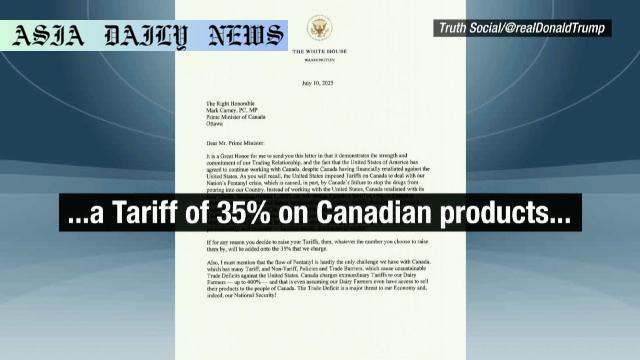Tariff: US President Donald Trump threatens to impose a 35% tariff on Canadian goods, escalating economic tensions amid trade talks.
- Key Point 1: President Trump plans to impose a 35% tariff on Canadian goods starting August 1, as per his social media announcement.
- Key Point 2: The US and Canada are actively negotiating a trade agreement amidst escalating tensions.
- Key Point 3: A 25% tariff is already in place due to concerns about illegal drug trade across borders.
- Key Point 4: Canada proposed removing the digital-services tax in an attempt to ease tensions with the US.

Introduction: Trump’s 35% Tariff Proposal Sparks Debate
The announcement by President Donald Trump to impose a 35% tariff on goods from Canada marks a significant development in the ongoing trade tensions between the two neighboring countries. Made public through social media, the move could have widespread implications for both economies. Trump’s letter to Canadian Prime Minister Mark Carney indicates that the tariff will take effect starting August 1. Currently locked in trade discussions, the US and Canada face increasing challenges in reaching an agreement. This proposed tariff heightens economic stakes, with potential ripple effects across North American markets.
Context of the Current US-Canada Trade Relations
The United States and Canada, historically close economic partners, are in the midst of challenging negotiations. The Trump administration has rationalized tariffs based on issues like illegal drug trafficking across the border. While a 25% tariff has already been imposed under these grounds, the new 35% tariff escalates an already tense situation. Notably, products covered under the USMCA (United States-Mexico-Canada Agreement) are exempt, which provides some relief but does little to dilute the broader economic impacts of such an imposition.
Canada’s Response to US Tariffs
In an effort to ease tensions and foster better diplomatic relations, the Canadian government has offered to scrap the digital-services tax that targets major technology firms, many of which are headquartered in the United States. By proposing this concession, Ottawa hopes to advance the trade talks and reach a resolution. However, experts warn that unilateral measures like aggressive tariffs could backfire, damaging not only Canadian exports but also American businesses and consumers who rely on Canadian goods.
Potential Economic Fallout
The introduction of a 35% tariff could potentially disrupt industry supply chains, drive up costs for consumers, and strain small businesses dependent on cross-border trade. The automotive, agriculture, and technology sectors may face significant challenges as they navigate these new barriers to trade. Such policies, while positioned to protect national interests, could unwittingly harm industries on both sides of the border.
Broader Implications for Economic Policy
This move by the Trump administration comes amid a broader trend of protectionism, wherein tariffs and trade restrictions are increasingly utilized as tools of economic leverage. Critics argue that such isolationist measures may alienate allies and impede global economic growth. The focus on Canada, one of America’s closest partners, underscores the friction at play in today’s economic landscape, making it imperative for both countries to seek collaborative solutions.
Conclusion: Path Forward for the US-Canada Relations
As the August 1 deadline looms, both nations must prioritize negotiation and diplomacy to avoid further economic strain. The ongoing talks represent a crucial opportunity to mitigate damage and ensure the stability of trade relations. Whether this 35% tariff becomes a reality or serves as a bargaining chip, its implications for North American economies cannot be overstated.



Commentary
Examining the Impacts of Trump’s 35% Tariff Threat
The proposed 35% tariff on Canadian goods by President Donald Trump has sparked widespread debate and concern. This move comes at a delicate time when the US and Canada are striving to strengthen their trade relations amidst ongoing negotiations. While the intention may be to secure American interests, such a drastic measure risks creating more harm than good for both countries.
Challenges for the Canadian Economy
Canada, a highly trade-dependent nation, could face substantial economic challenges if this tariff is implemented. Industries such as lumber, automotive manufacturing, and agriculture—key pillars of Canada’s export economy—might experience a sharp decline in demand. This could lead to lower revenues, job losses, and a potential contraction of the economy, which, in turn, could generate regional instability, impacting not just Canada but also its southern neighbor.
Effects on American Consumers and Businesses
The ripple effects of such a policy could extend to the United States as well. Increased costs for importing Canadian goods are likely to be passed down to American consumers, raising prices for essential goods and services. Moreover, businesses reliant on Canadian imports could see their profit margins squeezed. Small businesses, in particular, may struggle to cope, as they often lack the financial flexibility to absorb additional costs.
A Call for Negotiation Over Aggression
In conclusion, while the 35% tariff proposal reflects President Trump’s commitment to protecting American interests, it underscores the importance of diplomatic dialogue over economic aggression. Trade partnerships, especially between close allies like the US and Canada, should be nurtured rather than strained. Both nations would benefit from striving toward equitable solutions that strengthen their economic ties while addressing their respective concerns.